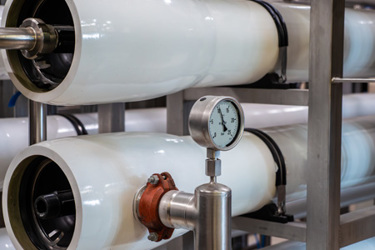New Research Could Extend Membrane Life And Lower Desalination Costs
By Christian Bonawandt

As water-scarce regions clamor for answers, developments in membrane anti-scaling bring desalination closer to viability.
Membrane desalination is a critical technology in addressing global water scarcity and promoting a circular water economy. However, the high costs associated with desalination often hinder widespread adoption. In addition to the high energy demand associated with desalination, scaling and fouling of membranes can significantly increase costs and reduce process efficiency. However, researchers from Arizona State University and Colorado State University have made what is being called a breakthrough in the understanding and mitigation of scaling1 caused by gypsum and silica. The findings, published in Frontiers of Environmental Science & Engineering, have the potential to notably improve the economics of desalination by enhancing operational efficiency and extending the lifespan of membranes.
Understanding Gypsum And Silica Scaling
Gypsum and silica scaling have distinct formation mechanisms, each influencing the thermodynamics, kinetics, and morphology of the scales. Gypsum scaling arises from a crystallization process involving the nucleation and growth of calcium sulfate dihydrate (CaSO4•2H2O) crystals. Earlier studies reveal that gypsum formation has multiple stages: the aggregation, rearrangement, and coalescence of nanocrystalline calcium sulfate clusters. This process can result in well-defined crystals with high aspect ratios, such as needles or rosettes, which adhere to membrane surfaces and impede water flux. Thankfully, gypsum scaling is relatively reversible and can often be addressed through physical cleaning.
In comparison, silica scaling stems from the polymerization of silicic acid, leading to the formation of amorphous silica deposits. Unlike gypsum, silica scales lack a crystalline structure, forming spherical particles that fuse into a gel-like layer on membrane surfaces. Silica scaling is notoriously difficult to reverse, with polymerized layers severely impairing membrane performance. As a result of these differences, desalination systems may require mitigation strategies tailored to each type of scaling.
Breakthroughs In Mitigation Strategies
The research indicates several innovative approaches can be used to mitigate both gypsum and silica scaling. For gypsum scaling, the new study proves the effectiveness of scaling-resistant membranes. In addition, hydrophilic polymer brushes, such as poly(methacrylic acid) and poly(acrylamide), reduce gypsum scaling by minimizing the attachment of gypsum nuclei. Similarly, zwitterionic polymers like poly(sulfobetaine methacrylate) (PSBMA) decrease gypsum adhesion, enhancing membrane performance. Superhydrophobic membranes with micro-pillar arrays can also be used in desalination to further mitigate scaling by reducing nucleation sites and promoting the detachment of gypsum crystals.
Additionally, researchers found antiscalants such as sodium hexametaphosphate (SHMP) and poly(acrylic acid) (PAA) inhibit gypsum nucleation and growth by interacting with calcium ions on the surface of nuclei. This increases the induction time for gypsum formation and prevents crystal growth. Pretreatment methods like nanofiltration (NF) also play a significant role by selectively separating ions, minimizing scaling during both pretreatment and subsequent reverse osmosis (RO) processes.
For silica scaling, researchers found scaling-resistant membranes with negatively charged surfaces are effective in repelling silica species, reducing local concentrations, and slowing polymerization. Antiscalants like poly(amidoamine) (PAMAM) and poly(ethylenimine) (PEI) hinder the polymerization of silicic acid, resulting in larger, slower-forming silica particles. Neutral polymers such as poly(ethylene glycol) (PEG) delay the formation of impermeable gel layers, enhancing resistance to silica scaling. Pretreatment approaches, including the use of nanomaterials like aluminum hydroxide and iron hydroxide, were also shown to efficiently adsorb silicic acid, while magnetic nanomaterials such as Al(OH)3@Fe3O4 offer the added advantage of easy recovery and reuse through magnetic separation.
Dual-Scale Mitigation Strategies
While each of the above-mentioned solutions can address either gypsum or silica scaling, the study uncovered some that address both. Among them is electrocoagulation, an electrochemical process that simultaneously removes dissolved silica and hardness. Lime-soda softening is another effective strategy, wherein lime (calcium hydroxide) and soda ash (sodium carbonate) are added to precipitate calcium, magnesium, and silica, reducing scaling potential. Ion exchange softening, a commonly used prefiltration technology, uses cation exchange resins to remove calcium and magnesium, while anion exchange resins eliminate reactive silica, thereby mitigating scaling from both sources.
Implications For Desalination Economics
The adoption of these advanced mitigation strategies can significantly improve the economics of membrane desalination in three key ways:
- Improved operational efficiency. Scaling-resistant membranes and targeted pretreatment methods maintain higher water flux, reducing the frequency of cleaning cycles and minimizing downtime.
- Reduced energy consumption. Scaling increases hydraulic resistance, leading to higher energy demands. Effective mitigation reduces this resistance, lowering energy costs.
- Increased longevity of membranes. By preventing irreversible damage, such as that caused by silica scaling, these strategies extend the usable life of membranes, reducing replacement costs.
Moreover, novel approaches like the use of magnetic nanomaterials and electrocoagulation offer sustainable and cost-effective alternatives to traditional methods. The ability to recover and reuse materials further reduces operational costs and environmental impact.
While the study’s results are promising, the researchers identified several areas that need further investigation. These include a deeper understanding of molecular interactions of scale precursors, an examination of the effect of temperature on scaling and scale prevention, and details on metal silicates, which have lower solubility than pure silica.
Researchers also noted that more studies are needed in realworld applications, particularly to analyze scale types formed from feedwaters with complex water chemistry. This includes feedwaters collected from various sources, such as industrial wastewater and natural waterbodies. Analyzing scale types on membrane surfaces in real desalination applications is important to ensure that mitigation strategies are effective in practical settings and thus further enhance the role of desalination in mitigating water scarcity.
References:
